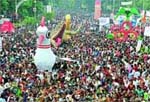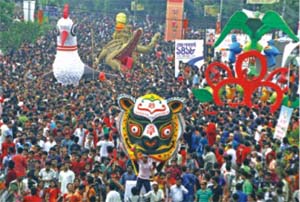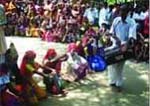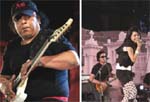The post Pahela Baishakh Celebration in Dhaka appeared first on Dhaka Mirror.
]]>Pahela Baishakh Celebration in Dhaka
 The nation welcomed ‘Pahela Baishakh’, the first day of the Bangla year 1418, on Thrusday amidst vibrant pageantry, leaving behind the gloom of the past and pledging to uphold the nation’s opulent cultural heritage.
The nation welcomed ‘Pahela Baishakh’, the first day of the Bangla year 1418, on Thrusday amidst vibrant pageantry, leaving behind the gloom of the past and pledging to uphold the nation’s opulent cultural heritage.Tens of thousands of people from all walks of life, in traditional clothes, poured into the streets, parks and open spaces across the capital and elsewhere in the country from early morning to welcome the Bangla New Year.
The tradition of celebrating the Bangla New Year — in relation to closing of the annual tax collection — started in the Mughal era. Traders and shopkeepers open ‘haal khata’ (new account books) on this day and offer sweets to clients.
In the course of time, it evolved into a day of celebration and an integral part of the Bengali culture, now considered the biggest secular festival as people irrespective of religion and class commemorate the day.
Chhayanaut, one of the leading cultural organisations of the country, has been holding their ‘barsho boron’ (New Year celebration) since 1967. On April 14, the New Year celebration at Ramna Botomul began with an instrumental recital on violin by Sheuli Bhattacharya. Sheuli played Raga Ramkeli. The melody stirred the senses as the sun slowly emerged and gleamed behind soft clouds.
Teachers, alumni and students of Chhayanaut presented solo, duet and group renditions and recitations at the event. Aside from renditions of morning raga-based songs of ‘Pancho-kobi’ (Rabindranath Tagore, Kazi Nazrul Islam, DL Roy, Atul Prasad and Rajanikant), the artistes also rendered several folk numbers on the occasion.
Secretary General of Chhayanaut, Khairul Anam Shakil, performed “Aaji Gao Mohageet”. Noted singers Mita Haque, Chandana Majumdar and Bizon Chandra Mistry rendered “Ondhojon-e Deho Aalo”, “Ke Banailo Emon Rong Mohol Khana” and “Oi Moha Sindhur Opar Thekey” respectively. A duet number, “Aaji Nutan-o Raton-e Bhushon-o Joton-e”, by Rezaul Karim and Nabanita Chakrabarti followed. “Probhat-o Beena Tabo Bajey”, “Trishit-o Akash Kanpey Re”, “Bhorer Hawaye” and more were the choruses performed by artistes.
Veteran singer Sushoma Das performed a Radharaman number while Elora Ahmed Shukla, Laisa Ahmed Lisa, Nasima Shaheen, Azizur Rahman Tuhin, Sejuti Barua and others also sang at the programme.
In her speech, President of Chhayanaut, Dr. Sanjida Khatun emphasised on fortifying our identity through ceaseless cultural practice and passion.
BTV, BTV World and Bangladesh Betar aired Chhayanaut’s ‘barsho boron’ programme live. This year Chhayanaut also celebrated its golden jubilee.
A festive spirit took over the capital and other parts of the country. Women in white saris with red borders and men in panjabi — decorated with Baishakhi motifs — ushered in the New Year.
Many had ‘panta bhat’ with fried hilsa, daal, green chilli and onion at home, restaurants and fairs. Youngsters had their cheeks painted with folk-themed emblems that added further colours to the celebration.
They thronged the main venue in Ramna. The festivities stretched over to Suhrawardy Udyan, Dhaka University and Dhanmondi Lake areas, bringing the city traffic system to a standstill. Many foreigners clad in traditional Bengali clothes were also seen in and around the venues of celebration.
The crowd turned into a human sea in the afternoon when the temperature came down slightly.
Another major attraction was the decorated procession called ‘Mongol Shobhajatra’, brought out by the students and teachers of Faculty of Fine Arts, Dhaka University. Dhaka University Vice Chancellor Professor AAMS Arefin Siddique with DU teachers and cultural personalities led the procession.
The ‘Shobhajatra’, featuring the giant replica of a crocodile (40 feet long) with three human figures riding on it, trying to kill it, symbolised wiping out the war criminals forever from Bangladesh. Replicas of two tigers also signified the embolden spirit of the nation. Thousands of people joined the procession, dancing along to the beats of dhol and other musical instruments.
There were scores of cultural shows arranged by different organisations, keeping the university area alive with heavy rush of people. It was a day of pure, unadulterated fun and merriment.
Courtesy of The Daily Star
The post Pahela Baishakh Celebration in Dhaka appeared first on Dhaka Mirror.
]]>The post Pahela Baishakh celebrated appeared first on Dhaka Mirror.
]]> The nation celebrated the Pahela Baishakh, the first day of the Bangla calendar, on Thursday amid traditional fanfare and festivity leaving behind the gloom of past and pledging to uphold the nation’s heritage.
The nation celebrated the Pahela Baishakh, the first day of the Bangla calendar, on Thursday amid traditional fanfare and festivity leaving behind the gloom of past and pledging to uphold the nation’s heritage.Tens of thousands of people from all walks of life dressed in traditional clothes poured into the streets, parks and open spaces across the capital and elsewhere in the country to welcome the year 1418.
Attired in traditional clothes, mostly sari and punjabi, they thronged venues of cultural programmes and makeshift fairs throughout the day.
Many expressed the determination to move forward with a vision to build a prosperous future through this year’s carnival of Pahela Baishakh with traditional songs, music, fanfares and colourful processions.
The day was a public holiday.
The biggest venue of the celebration was set at the Ramna Batamul, where programmes started with a Chhayanaut performance of Rabindranath Tagore’s song “Esho he Baishakh…”
Different cultural organisations and popular bands performed at the venue throughout the day as more people poured in.
The traditional colourful procession, known as Mongol Shobhajatra, organised by the students of the Institute of Fine Arts of Dhaka University, also began from its premises.
The Shobhajatra featuring giant replicas of tiger, cat, owl, tortoise, elephant and huge colourful masks symbolises triumph of good over evil. Tens of thousands of people joined the Shobhajatra dancing along the beats of traditional musical instruments.
Makeshift fairs, cultural performances and celebration programmes were organised by different organisations across the country.
Many ate traditional panta bhat (watered rice) with fried hilsa, lentil, green chilli and onion at home, restaurants and fairs.
The Central Shaheed Minar, Dhanmondi, and Jatiya Sangsad Bhaban areas were also seen swarmed with people since early morning till night.
No major untoward incidents were reported thanks to the tight security measures around the celebration venues.
Mughal Emperor Akbar introduced the tradition of celebrating the Bangla New Year in relation to closing of the annual tax collection. Traditionally, traders and shopkeepers open halkhata (new account register) on this day and serve sweetmeats to clients.
In the course of time, it evolved into a day of celebration and an integral part of the Bangalee culture. It is a non-communal festival as people irrespective of their religion, sect and creed celebrate the day as one nation.
The most visible aspect of the Pahela Baishakh was sprinkles of rural life that generally goes amiss in the everyday hustle and bustle of modern life.
The state-owned BTV, Bangladesh Betar (radio), and all private television channels broadcast special programmes and the newspapers brought out special supplements marking the day.
Various professional, political, social and cultural organisations also held programmes to celebrate the day.
Courtesy of The Daily Star
The post Pahela Baishakh celebrated appeared first on Dhaka Mirror.
]]>The post Pahela Baishakh: Symbol of the timeless appeared first on Dhaka Mirror.
]]>For the Bangalees, like millions of others across the globe, have a claim on history based on the cultural tradition their ancestors shaped for them, one that they renew annually through Baishakh. There are the currents and cross-currents of history which have given Baishakh roundness of a throbbing sort. It is these underpinnings of the season, indeed the beginning of a new year, that the Bangalees remember today.
There is the essential point of reference that was Akbar. The haal khata, the closing off of a year just ended and the commencement of a new one, a stocktaking of crops, indeed of productivity are the underpinnings we speak of.
There is, then, about Baishakh something of the pastoral. In that larger sense of the meaning — and quite removed from the formalities attendant on its advent in these largely urban times — it is the village, that timelessness of agrarian life that Baishakh recalls every year. There is a plenitude of colour, an abundance of music redolent of Baishakh. Add to that colour and to that melody the power of nature to remind the world of what it does or can do to make its presence felt yet once again. In the lowing clouds hanging over the rustic fields, in the winds which sweep across the earth before flashes of lightning and ferocity of thunderclaps precede the fall of rain across the land comes that reminder of Baishakh being a particularly a local affair for the people of this land as it is of the half of it that is today part of another land. Baishakh goes beyond the frontiers that demarcate the political realities which today define life in what once was one whole, unified Bengal.
And yet Baishakh brings all Bangalees — here and over there and all across the Bangalee diaspora — together in a spontaneous offering of homage to the land and to the natural elements that have kept it going for thousands of years. Baishakh is all that and much more. It is a symbolism of all the good the Bengalis can claim for themselves through the poetry flowing from the minds of its greatest men. Rabindranath Tagore, Kazi Nazrul Islam, Dwijendra Lal Roy, Atulprasad and so many others have sung paeans to Bengal through the media of song and dance. Through the mysticism which defines faith, through the devotional songs of Lalon and Hason Raja, Baishakh rediscovers the aesthetics of life in these parts.
Yes, this morning it is truly a celebration of the past we lose ourselves in. Baishakh is all about losing oneself in order to reinvent oneself. The Bengali spirit that has all so often been a hallmark of its politics and its poetry once more goes back to the magic inherent in its heritage in order to expand the cultural parameters of the future.
In Baishakh, there are all the intimations of rain about to descend to earth, of storms ready to blow, of the rainbow taking hold of the imagination. In the waterfall laughter of women is a lilt touching the soul, ever so softly. In the conversations of men are heard the stirrings of the flute which long ago were coursed through the hamlets of this land and will be heard once again this morning.
On Pahela Baishakh, we celebrate ourselves. We celebrate all that is of us, that had been our ancestors’ and that will be our children’s.
Shubho Nababarsha!
Courtesy of The Daily Star
The post Pahela Baishakh: Symbol of the timeless appeared first on Dhaka Mirror.
]]>The post Chaitra Sankranti, Pahela Baishakh in rural Bangladesh appeared first on Dhaka Mirror.
]]> Most communities in rural Bangladesh celebrate Chaitra Sankranti and Pahela Baishakh following the age-old traditions. The celebrations bring together people, irrespective of their creed and social differences.
Most communities in rural Bangladesh celebrate Chaitra Sankranti and Pahela Baishakh following the age-old traditions. The celebrations bring together people, irrespective of their creed and social differences.Usually rural people arrange weeklong programmes to celebrate the end of a year and the beginning of another. The preparations start a month before Chaitra Sankranti and Pahela Baishakh. An interesting aspect of these festivals is that Chaitra Sankranti has more colour than Pahela Baishakh.
The festivities begin with ‘Gajoner Mela’ and ‘Charok’ — two major elements of Chaitra Sankranti celebration. Among Bengalis and other ethnic minorities (also known as indigenous people) the nature of the celebrations may vary, but the spirit is the same: well wishes, merriment and festivity.
Events usually included in such festivals can be categorised in three groups: ritual based performances, customs and traditions, and entertainment.
Various ritualistic performances reflecting the age-old belief of rural people are important aspects of the Chaitra Sankranti festivity. In the rural areas, the Hindus perform several ritualistic art forms such as Kanta Bhanga-Hajrapita, Ashtogaan and Gourakkho Puja throughout the Bengali month of Chaitra, particularly on Chaitra Shankranti.
On the eve of Chaitra Sankranti, Sanyasis demonstrate their ability to endure extreme pain and discomfort by piercing their bodies with sharp objects.
Sanyasis of the Baishna Kapali Sampraday (a Hindu cult) believe that the ritualistic Hajrapita-Kanta Bhanga on the Chaitra Sankranti eve has the effect of exorcism— believing that it would free them of evil in the coming year.
With painted bodies, and wearing long hair and carrying tridents and other sharp objects, they give a horrifying and hypnotic performance by climbing on top of khejur trees and smashing thorns with their bare toes.
Ashtogaan is another kind of ritualistic kirtan-based performance practised throughout the month of Chaitra by the Hindu communities in the rural areas of southwestern Bangladesh. Ashtogaan highlights the essence of divine love for humanity through narrating the myths of the four great epochs in Hinduism: Satya Jug, Treta Jug, Dwapar Jug and Koli Jug. Leela (feats celebrating divinity) of Lakshmi-Narayan, Ram-Sita, Radha-Krishna and Gaor-Nitai are performed as representations of the four ages.
The artistes involved in these performances narrate Leelas with painted faces outside houses. During the narration, artistes enact the roles of Narayan, Ram, Krishna Lakshmi, Sita, Radha and other divine beings. The tune is similar to that of kirtan. Typical instruments like harmonium, dholok, kartal and bansi are used. The choir presents a part of the performance at one house and then moves to another house – a practice which can be likened to travelling theatre.
Another type of ritualistic performance is Gourakkho Puja which is usually performed at the cowsheds on the Pahela Baishakh eve by ringing bells and chanting for the well being of the cattle owned by both Hindus and Muslims in the South-West part of the country. The tune of performance is also similar to traditional kirtan.
Such celebration of the Chaitra Sangkranti and Pahela Baishakh, one after the other, creates opportunities for the artisans to sell handicrafts at the ‘Chaitra Sankranti Mela’. The mela is the most colourful event on Chaitra Shankranti and Pahela Baishakh. People from all communities participate in the festivities.
Though this type of mela is popularly known as Baishakhi mela in the urban areas, in the villages these fairs begin on Chaitra Shankranti eve and continue for a week. They are also known as ‘Gajoner Mela’.
Agricultural products, traditional handicrafts, handmade toys, as well as food and sweets are sold there. These events also provide entertainment — with singers, dancers and jatra. Snake charmers display their prowess over hooded cobras.
A highlight of Pahela Baishakh is to open a halkhata (a new book of accounts), which has been a tradition since the times of the Mughal Emperor Akbar. Initially it was a financial affair but now halkhata has become an inseparable custom of Baishakhi celebrations.
The traders and businessmen close their old account books and open new ones. They invite their customers to share sweets and renew their business ties. Traders of all communities observe the day.
Music is definitely the main attractions during the period presented in melas and at times by a ghat or under a big tree. Alongside baul songs, traditional artistes perform other folk genres such as pallapalli gaan, jari gaan and Gazir gaan.
The rural people also enthusiastically participate in several traditional sports like lathikhela, ha-du-du and dariyabanda. Professional lathials display their prowess and mettle in this game where the players combat with bamboo sticks, swords and spears with the beats of dhol and kansha.
Indigenous groups living across the country also celebrate Chaitra Sangkranti and Pahela Baishakh.
Courtesy of New Age
The post Chaitra Sankranti, Pahela Baishakh in rural Bangladesh appeared first on Dhaka Mirror.
]]>The post Pahela Baishakh today appeared first on Dhaka Mirror.
]]> Dhaka: The nation is all set to welcome Bangla year 1418, with festivities and gaiety, with the rising of the sun on Thursday, leaving behind all sorrow and despair.
Dhaka: The nation is all set to welcome Bangla year 1418, with festivities and gaiety, with the rising of the sun on Thursday, leaving behind all sorrow and despair.Thousands of men, women and children, in traditional colourful clothes, will throng Ramna Batamul and other prominent venues for new year celebrations in the capital and elsewhere in the country, to make the first day of the Bangla year a memorable one. Three-tier security systems have been put in place at the popular and traditional centres of celebration around Ramna Park, Suhrawardy Udyan and Dhaka University (DU) campus. Around 11,000 members of police, RAB and Detective Branch of police will keep vigil round-the-clock, at venues across Dhaka, to ward off any untoward incident.
“A total of 33,000 police, RAB and intelligence personnel would be deployed across the country, including 175 strategic points in Dhaka, on Thursday,” state minister for home, Shamsul Haque Tuku, told reporters. The minister said that special intelligence surveillance was already in place at strategic areas in the capital, ahead of Pahela Baishakh.
Tuku said no hawker would be allowed into Ramna Park on Pahela Baishakh and all visitors heading to Ramna Batamul can enter the park through designated gates, after necessary security checks by members of the law-enforcement agencies. People have also been asked to refrain from smoking in the venue and not to carry match boxes or lighters. About 30 closed-circuit TVs have been installed in various places, while 47 check-posts and eight archways have been set up to boost security. After visiting Ramna Park yesterday, the minister and state minister for home affairs, and the chiefs of law enforcement agencies expressed their satisfaction over the security measures in place.
RAB officials said that 5,500 members of the force have been deployed across the country. Of them, 2,500 are deployed in Dhaka. Thousands of people are expected to gather at Ramna Udyan, where, artistes from cultural organisation Chhayanaut will sing “Esho Hey Baishakh Esho Esho”, a traditional favourite from Rabindranath Tagore, to welcome the new year.
Members of the Institute of Fine Arts will bring out the coulourful Mangal Shobhajatra procession, from the institute’s gate in the morning. Besides, cultural functions are to be held at Ramna Udyan, Institute of Fine Arts of Dhaka University and elsewhere in the capital.
People from all walks of life are expected to throng Baishakhi Mela – a major feature of Bangla New Year celebration. The 10-day traditional and colourful fair, arranged jointly by Bangladesh Small and Cottage Industries Corporation (BSCIC) and Bangla Academy, begins Thursday, on the Bangla Academy premises.
As the day is a public holiday, different social, political and cultural organisations have drawn up elaborate schedules to celebrate the day. Those who like to stay back at home and enjoy a leisurely pace of life, will likely have panta bhaat and fried hilsa, with lentils and green chillies, at home and Baishakh gatherings.
Bangladesh Betar and all television channels air special programmes, while newspapers publish special supplements.
Dhaka Metropolitan Police said the roads stretching from Sheraton crossing to Hare Road-Kakrail crossing, from Shahbagh to Matsya Bhaban, from Nilkhet crossing to Teachers-Students Centre (TSC) of Dhaka University, from Plassey intersection to Doyel Chattar via Shaheed Minar, and Bakshi Bazar to TSC crossing via Jagannath Hall, will be off-limits for vehicles. President Zillur Rahman and Prime Minister Sheikh Hasina, in separate messages, greeted countrymen and expatriate Bangladeshi citizens, on the occasion of Pahela Baishakh. They expressed hopes that the Bengali New Year would bring joy to all and unite everyone to build a prosperous nation.
The President and the Prime Minister, in their messages, said Pahela Baishakh is a unique day for nurturing Bangladesh’s everlasting tradition and Bengali lifestyle, to move forward with new strength and feelings. The President will host a Pahela Baishakh reception at Bangabhaban, at 7.15pm on Thursday. Prime Minister Sheikh Hasina is expected to attend the function.
The post Pahela Baishakh today appeared first on Dhaka Mirror.
]]>The post Robi Bangladesh Mela at Suhrawardy Udyan appeared first on Dhaka Mirror.
]]> One of the leading mobile operators in the country, Robi, marked the first anniversary of its re-branding. Robi, earlier known as AKTEL, arranged ‘Bangladesh Mela’ for the second time. Showcasing Bangladesh’s opulent culture and heritage, the daylong fair was held at Suhrawardy Udyan in Dhaka on March 28. Robi also arranged cultural programmes countrywide on the day.
One of the leading mobile operators in the country, Robi, marked the first anniversary of its re-branding. Robi, earlier known as AKTEL, arranged ‘Bangladesh Mela’ for the second time. Showcasing Bangladesh’s opulent culture and heritage, the daylong fair was held at Suhrawardy Udyan in Dhaka on March 28. Robi also arranged cultural programmes countrywide on the day.Pop star Mila performed her hits “Dola” and “Tumi Ki Shara Debey” while the uncrowned queen of folk songs Momtaj rendered her ever-popular “Morar Kokiley” and “Nantu Ghatok” at the event. Lux-Channel i Superstar Bidya Sinha Saha Mim danced to the song “Amar Achhey Jol” [recorded by actress-singer Shaon]. Rock bands LRB, Metal Maze and others also performed on the day.
Robi also honoured 11 Birangana [woman freedom fighters]. Following a brief speech, Axiata Bangladesh Ltd’s Chief Marketing Officer, Bidyut Kumar Basu, awarded them. The awardees also expressed their views on the occasion.
The highlight of the event was the launch of the Robi theme Song “Amar Robi”. Singer Hridoy Khan has lent his voice to the song that was formerly recorded by singer Momtaj. Filmmaker Mostofa Sarwar Farooki has directed the music video for the song. An exclusive laser show featuring Bangladesh’s cultural elements, history, heritage and architecture followed.
The stage was aesthetically designed. Seeing phanush (traditional balloons) making their way to the sky was an amazing experience. Replicas of Cox’s Bazar, Sundarban, Shaheed Minar, the gate of Lalbagh Fort, several book stalls, nagardola and more were big draws at the fair.
The turnout was impressive, especially in the evening. People from all walks of life enjoyed the event.
Courtesy of The Daily Star
The post Robi Bangladesh Mela at Suhrawardy Udyan appeared first on Dhaka Mirror.
]]>The post History in Flashes appeared first on Dhaka Mirror.
]]> Starting from March 7, a three-daylong light and sound show, titled “Bangladesh-er Hridoy Hotey”, was held at Suhrawardy Udyan. The show was held to celebrate the ‘month of independence’.
Starting from March 7, a three-daylong light and sound show, titled “Bangladesh-er Hridoy Hotey”, was held at Suhrawardy Udyan. The show was held to celebrate the ‘month of independence’.Our national flag was hoisted for the first time in this month [March 2] in 1971. Bangabandhu delivered his historic speech on March 7, 1971. Following the black night of atrocities, the declaration of independence went on air on March 26, 1971.
Planned and directed by Nasirul Haque Khokon, the light and sound show presented a thousand year-old history tracing the origin of Bangladesh. Scripted by Sohel Anwar, the show featured narration by eminent actor and reciter Asaduzzaman Noor.
Starting with a Tagore song, “Sharthok Janam Amar”, the documentary portrayed Bangabandhu’s historic March 7 speech, reference to history in poetry and music. Two poems — “Amar Porichoy” by Syed Shamsul Haque and “Shadhinota Ei Shabdo-ti Kibhabey Amader Holo” by Nirmolendu Guun — were part of the presentation.
Students’ Movement in 1962, Bangabandhu’s declaration of six point charter in 1966, Agartala Conspiracy Case in 1968, Mass Upsurge in 1969, AL’s unprecedented victory in the 1970 election and finally Liberation War in 1971 were evocatively presented in the show.
Artistes from several theatre troupes — Centre for Asian Theatre, Theatre (Baily Road), Prachyanat, Dhaka Padatik, Natyachakra, Nagarik Natyangan, Palakar, Sanglap, Bongorango and Kranti — made the presentation exciting as they performed to Shamsur Rahman’s poems “Barnaomala Amar Dukhini Barnomala” and “Asad-er Shirt”. Actors also donned the roles of martyred intellectuals like Munier Chowdhury, Shahidullah Kaisar, Zahir Raihan, GC Dev and others.
General Niazi with 93000 soldiers surrendered on December 16, 1971 at Suhrawardy Udayan (then Racecourse Maidan). Bangabandhu also delivered his homecoming speech on January 10, 1972 at this venue. The documentary did not miss any of these historic moments.
Nasirul Haque Khokon and Junaed Yusuf jointly designed the lights while Ahsan Reza Tushar designed the sound. Mohammad Rafi Suman directed the choreography. Ramzan Ali edited the documentary while Nur Uddin Faruk Shuvo was in charge of graphics design.
Courtesy of The Daily Star
The post History in Flashes appeared first on Dhaka Mirror.
]]>The post Underground museum likely to see light March 26 appeared first on Dhaka Mirror.
]]>The underground liberation war museum at Suhrawardy Udyan in the capital city is likely to be officially inaugurated on the upcoming Independence Day, March 26.
The museum will feature photographs, projection room and articles representing and reminiscing the period from 1948 to the Independence War of 1971.
The project officials, however, expressed uncertainty about the inauguration of the museum on the expected date as the decoration work was yet to start.
According to the Public Works Department sources, the museum was handed over to the liberation war ministry in 2007 after construction works which was a part of Swadhinata Stambha (independence monument) Project.
The museum has an entry room, a black-stone room dedicated to the memory of March 25, 1971, a room featuring display of light and water and a room which will give space for other museums to showcase their items on liberation war on a temporary basis, said the project’s sub-assistant engineer ABM Kawsar Hossain.
He told New Age that the museum has a 157-seat audio-visual auditorium where documentaries on liberation war will be screened, some glasses on the roof to let light into the museum during load-shedding and in the outside there are some closed-circuit television cameras, a plaza square with a little monument and artificial water body.
‘We have made arrangement for people with disabilities so that they can enter the museum easily. There is a lift and sloppy pathways inside and outside the museum,’ he said, adding that the police and Ansar members were maintaining security of the premises.
Asked why the decoration work was yet to begin, Kawsar Hossain said the liberation war affairs ministry was responsible for the decoration of the museum and the liberation war museum would also assist the ministry in the work.
‘It is their part of works, not ours,’ he said, adding, ‘we only constructed the structure.’
The project’s another sub-assistant engineer, Mohammad Bazlul Rahman, said the museum was already centrally air-conditioned and lights would be fixed at any time.
‘The decoration work is scheduled to be finished before March 26 but it is hardly possible to finish any work in time in Bangladesh, you know,’ he said.
They further said the visitors would require to buy tickets to enter the museum.
A high official of the project cell at the public works department, seeking anonymity, said a total of Tk 1 crore was estimated for the museum’s decoration.
He said at present there was nothing in the museum and it has remained empty since 2007.
‘It is already mid-January and we have only one and half month,’ he said, adding, ‘you see there are so many works yet to be done while the time is very short.’
The visitors, coming to Suhrawardy Udyan to spend hours sitting on benches near the artificial water-body and Shikha Chirantan, were totally unaware of the museum.
Jewel, a former student of Dhaka College who was sitting just outside the museum, said he used to visit this place but never heard of any museum there.
Dhaka University’s public administration department’s student Ahsan said he was also unaware of the museum.
‘There is no signboard or mark of a museum!’ he said, exclaiming, ‘It is very interesting that an underground museum is beneath my foot.’
The project’s officials, admitting to lack of publicity for the museum, said the journalists should come forward to make people know about this museum.
The post Underground museum likely to see light March 26 appeared first on Dhaka Mirror.
]]>